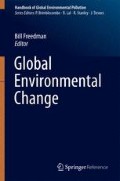Abstract
Plant communities have been transformed by global changes such as land-use change and biological invasion in recent decades, and climate change will drive further transformation in the coming decades. Plant species can respond to changing climates by shifting their ranges to new areas in order to track optimal conditions and/or by adapting to these changes in situ. Future climates have the potential to alter species’ productivity, phenology, and biotic interactions. In addition, species’ ranges are expected to shift towards higher latitudes, tracking favorable climate conditions as the planet warms. The same trend is expected along altitudinal gradients, where species are expected to move uphill. However, distributions of communities and ecosystems depend on their individual species’ responses to climate change and are therefore more complicated to predict. Future plant community assemblages will differ from the ones that have existed historically, and these changes could themselves influence the rate of global climate change.
Access this chapter
Tax calculation will be finalised at checkout
Purchases are for personal use only
References
Elith J, Leathwick JR (2009) Species distribution models: ecological explanation and prediction across space and time. Annu Rev Ecol Evol Syst 40:677–697
Hättenschwiler S, Körner C (1995) Responses to recent climate warming of Pinus sylvestris and Pinus cembra within their montane transition zone in the Swiss Alps. J Veg Sci 6:357–368
Hellmann JJ, Byers JE, Bierwagen BG, Dukes JS (2008) Five potential consequences of climate change for invasive species. Conserv Biol 22(3):534–543
Jump AS, Mátyás C, Peñuelas J (2009) The altitude-for-latitude disparity in the range retractions of woody species. Trends Ecol Evol 24:694–701
Knapp AK, Beier C, Briske DD, Classen AT, Luo Y, Reichstein M, Smith MD, Smith SD, Bell JE, Fay PA, Heisler JL, Leavitt SW, Sherry R, Smith B, Weng E (2008) Consequences of more extreme precipitation regimes for terrestrial ecosystems. Bioscience 58(9):811–821
Lavergne S, Mouquet N, Thuiller W, Ronce O (2010) Biodiversity and climate change: integrating evolutionary and ecological responses of species and communities. Annu Rev Ecol Evol Syst 41:321–350
Lenoir J, Gegout JC, Guisan A, Vittoz P, Wohlgemuth T, Zimmermann NE, Dullinger S, Pauli H, Willner W, Svenning JC (2010) Going against the flow: potential mechanisms for unexpected downslope range shifts in a warming climate. Ecography 33:295–303
Morgan JA, LeCain DR, Blumenthal DM, Kimball BA, Carrillo Y, Williams DG, Heisler-White J, Dijkstra FA, West M (2011) C4 grasses prosper as carbon dioxide eliminates desiccation in warmed semi-arid grassland. Nature 476:202–206
Walther G (2003) Plants in a warmer world. Perspect Plant Ecol Evol Syst 6:169–185
Wu A, Dijkstra P, Koch GW, Peñuelas J, Hungate BA (2011) Responses of terrestrial ecosystems to temperature and precipitation change: a meta-analysis of experimental manipulation. Glob Chang Biol 17:927–942
Additional Recommended Reading
Franklin J (2009) Mapping species distributions: spatial inference and prediction. Cambridge University Press, New York
Loarie SR, Duffy PB, Hamilton H, Asner GP, Field CB, Ackerly DD (2009) The velocity of climate change. Nature 462:1052–1055
Sala OE, Chapin FS III, Armesto JJ, Berlow E, Bloomfield J, Dirzo R, Huber-Sanwald E, Huenneke LF, Jackson RB, Kinzig A, Leemans R, Lodge DM, Mooney HA, Oesterheld M, Poff NL, Sykes MT, Walker BH, Walker M, Wall DH (2000) Global biodiversity scenarios for the year 2100. Science 287:1770–1774
Schweiger O, Biesmeijer JC, Bommarco R, Hickler T, Hulme PE, Klotz S, Kühn I, Moora M, Nielsen A, Ohlemüller R, Petanidou T, Potts SG, Pyšek P, Stout JC, Sykes MT, Tscheulin T, Vilà M, Walther GR, Westphal C, Winter M, Zobel M, Settele J (2010) Multiple stressors on biotic interactions: how climate change and alien species interact to affect pollination. Biol Rev 85:777–795
Thuiller W, Albert C, Araújo MB, Berry PM, Cabeza M, Guisan A, Hickler T, Midgley GF, Paterson J, Schurr FM, Sykes MT, Zimmermann NE (2008) Predicting global change impacts on plant species’ distributions: future challenges. Perspect Plant Ecol Evol Syst 9:137–152
Williams JW, Jackson ST (2007) Novel climates, no-analog communities, and ecological surprises. Front Ecol Environ 5:475–482
Author information
Authors and Affiliations
Corresponding author
Editor information
Editors and Affiliations
Rights and permissions
Copyright information
© 2014 Springer Science+Business Media Dordrecht
About this entry
Cite this entry
Schuster, M.J., Martinez, L.T., Dukes, J.S. (2014). Distribution of Terrestrial Ecosystems and Changes in Plant Community Composition. In: Freedman, B. (eds) Global Environmental Change. Handbook of Global Environmental Pollution, vol 1. Springer, Dordrecht. https://doi.org/10.1007/978-94-007-5784-4_31
Download citation
DOI: https://doi.org/10.1007/978-94-007-5784-4_31
Published:
Publisher Name: Springer, Dordrecht
Print ISBN: 978-94-007-5783-7
Online ISBN: 978-94-007-5784-4
eBook Packages: Earth and Environmental ScienceReference Module Physical and Materials ScienceReference Module Earth and Environmental Sciences

